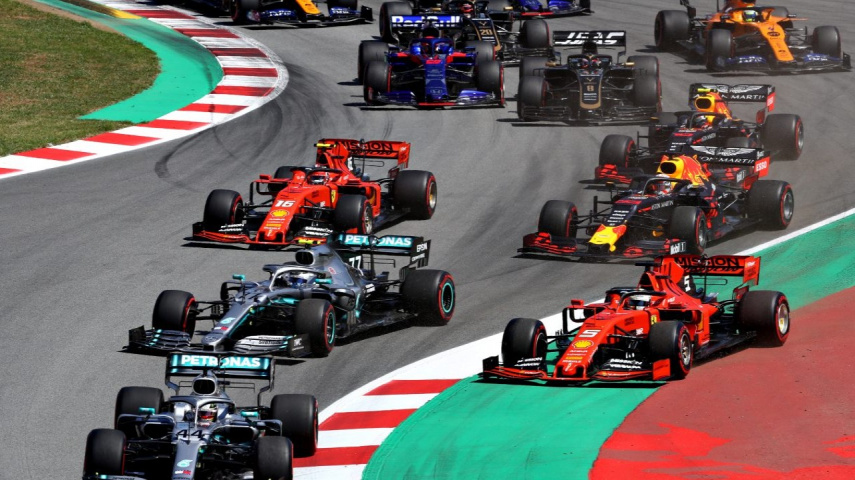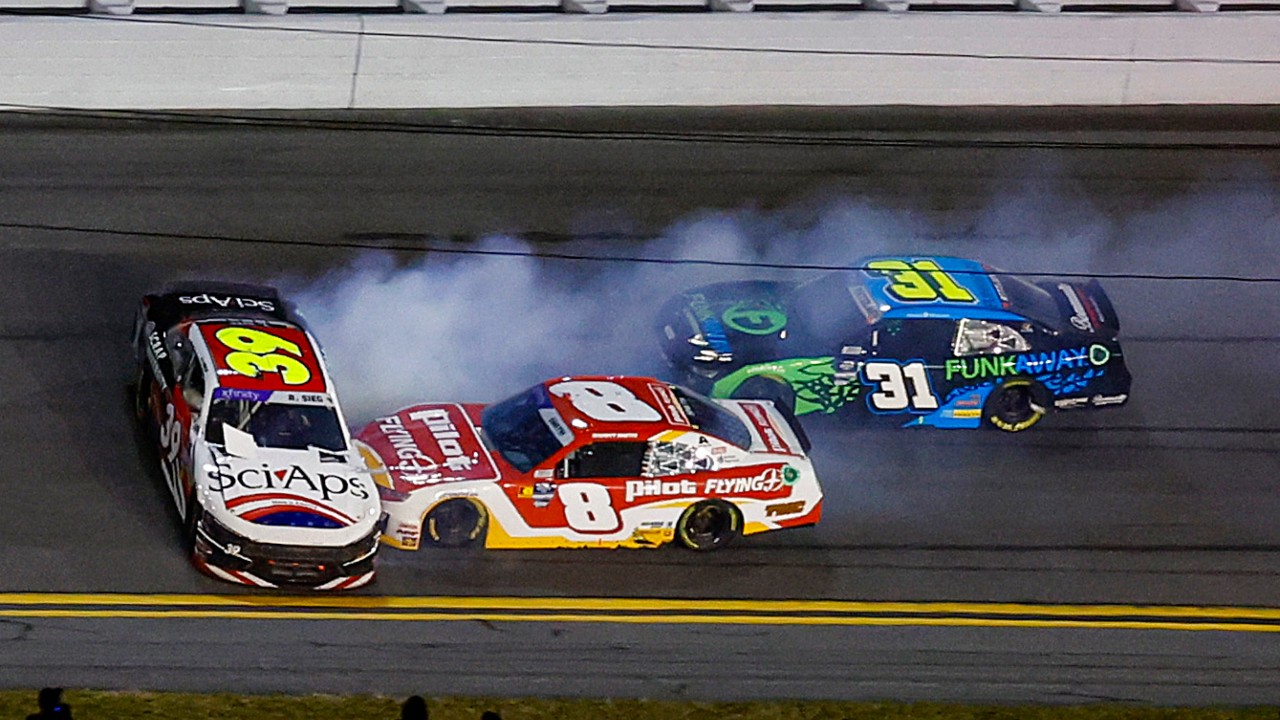How Fast Do F1 Cars Go? Find Out Top Speeds Of F1, NASCAR, MotoGP And More
Find out How Fast Do F1 Cars Go? Read about the top speeds of the top tiers of motorsport such as F1, NASCAR, MotoGP And More on Pinkvilla.

In the thrilling world of motorsports, speed is the essence that keeps fans on the edge of their seats.
From the engineering marvels of Formula 1 to the raw power of NASCAR, each series offers a unique blend of speed, technology, and competition.
But just how fast do these machines go?
In this article, we dive into the top speeds of some of the most exhilarating motorsports: F1, NASCAR, MotoGP, IndyCar, Formula E, WRC, and V8 Supercars.
Prepare to be amazed by the sheer velocity these vehicles can achieve.
Formula 1

Top race speed: 372.5km/h / 231.4mph
Acceleration: 0-60mph - approximately 2.6s
The record speeds observed in F1 are notably Daniel Ricciardo's 353.8 km/h in qualifying and Valtteri Bottas's 372.5 km/h (231.4 mph) during the 2016 Mexican Grand Prix.
The quest for speed has led teams to explore the limits of what's possible with an F1 car.
A notable attempt was by Honda at the Bonneville Salt Flats, a legendary venue for speed records.
Although their goal to break the 400 km/h barrier was not achieved, the RA106 reached a top speed of 397.36 km/h (246.9 mph), setting a record for the highest speed achieved in an F1 car.
Formula 1 cars are the epitome of high-speed automotive technology, designed to extract every ounce of performance.
The result is a vehicle that can accelerate from 0 to 60 mph in approximately 2.6 seconds. While this figure might not seem extraordinary at first glance, especially when compared to the ultimate top speeds these cars can achieve, it's the science behind the acceleration that astounds.
Their acceleration capabilities, while impressive, are just the tip of the iceberg. Much of an F1 car's speed comes from its aerodynamics, which is optimized for high velocities.
These vehicles are designed to generate massive amounts of downforce, which presses the car into the track, increasing grip and allowing for higher speeds in corners.
At lower speeds, such as from a standing start, these aerodynamic features are not as effective, which is why the full potential of an F1 car unfolds as it gains speed.
The Autodromo Hermanos Rodriguez in Mexico city, situated 7,500 feet above sea level, offers a unique setting where the thin air reduces aerodynamic drag, allowing cars to reach higher top speeds.
This is further aided by the circuit's 1200m main straight, one of the longest in the F1 calendar, providing an ideal stage for pushing the boundaries of top speed.
Despite these high-speed achievements, it's important to note that F1 cars are not purely about straight-line speed.
Their design prioritizes downforce and cornering speeds, which, while limiting their maximum speed compared to IndyCars, ensures faster lap times over an entire circuit.
This was evident at the Circuit of the Americas, where despite IndyCar's higher straight-line speed, F1's focus on aerodynamics and cornering allowed Valtteri Bottas to secure a pole time significantly faster than the best IndyCar lap.
The speed and acceleration of F1 cars are a testament to the sport's cutting-edge technology and engineering. The blend of power, aerodynamics, and driver skill makes Formula 1 a pinnacle of motorsport, where speed is matched by strategic precision and technical excellence.
NASCAR

Top speed: 380km/h / 236mph
Acceleration: 0-100km/h in approximately 3s
While NASCAR vehicles boast impressive top speeds and acceleration, since the 1980s, NASCAR has implemented restrictions on the top speeds of its cars, a move prompted by several high-profile incidents.
Despite these restrictions, the cars achieve remarkable speeds, with Jimmie Johnson hitting the top speed chart at the 2023 Daytona 500 with 312.57 km/h (194.2 mph), showcasing the cars' capabilities within the safety parameters.
NASCAR, an acronym for the National Association for Stock Car Auto Racing, represents one of the most popular forms of motorsport in the United States.
Known for its close, competitive racing, NASCAR has a rich history that dates back to the bootleggers of the Prohibition era. The technological evolution of NASCAR cars has been heavily influenced by the need to balance speed with safety.
The introduction of restrictor plates and, more recently, tapered spacers, are examples of how NASCAR has regulated engine power to control speeds, especially at its fastest tracks like Daytona and Talladega.
Johnson's 2023 performance in this race, with an average pace of 233.81 km/h (145 mph), underscores the series' ability to maintain a fast, competitive pace over the course of an entire race, not just in short bursts.
NASCAR vehicles are heavier and have a different aerodynamic setup compared to open-wheel racers like IndyCars, which impacts their overall top speed and acceleration.
Teams spend countless hours in wind tunnels and on computational fluid dynamics (CFD) simulations to fine-tune the aerodynamic performance of their cars, seeking every possible advantage within the tight regulations set by NASCAR.
NASCAR series' most iconic races, such as the Daytona 500 and the Coca-Cola 600, test not only a driver's ability to perform at high speeds but also their endurance and strategic acumen.
MotoGP

Top speed: 366.1km/h / 227.4mph
Acceleration: 0-100 km/h in approximately 2.6s
Brad Binder's record-breaking sprint of 366.1 km/h at Mugello during the 2023 Italian Grand Prix sprint race underscores the sheer velocity Moto GP bikes can achieve.
The record set by Binder at Mugello broke the previous top speed record of 363.6 km/h, set by Jorge Martin in 2022, illustrating the ongoing evolution of speed in MotoGP.
These motorcycles outpace their Moto2 and Moto3 counterparts significantly, with top speeds exceeding 295 km/h and 245 km/h, respectively, emphasizing the technological and power gap within the classes.
MotoGP bikes represent the zenith of motorcycle performance, capable of reaching breathtaking speeds that rival even the fastest automotive racing machines.
MotoGP bikes' acceleration from 0-100 km/h in around 2.6 seconds is comparable to that of Formula 1 cars. However, achieving speeds of 300 km/h takes MotoGP bikes around 11.8 seconds from a standstill, highlighting the different performance characteristics between motorcycles and F1 cars.
Despite the incredible top speeds, F1 cars benefit from higher cornering speeds due to their aerodynamic downforce due to the inherent differences in aerodynamics and contact patch between two and four-wheeled vehicles.
But MotoGP bikes excel in straight-line speed and agility. Evident by the difference in lap times, as seen in the 2023 Austrian Grand Prix, where Max Verstappen's pole time (1m04.391s) significantly outpaced that of MotoGP's Francesco Bagnaia pole time (1m28.539s).
IndyCar

Top speed: 380km/h / 236mph
Acceleration: 0-100km/h in approximately 3s
In 2023, Alex Palou demonstrated IndyCars speed beautifully by securing the pole position for the Indy 500 with an astounding average speed of 234.217 mph (376.936 km/h) across four laps.
Yet, even this feat pales in comparison to the record set by Arie Luyendyk in 1996. Luyendyk averaged 236.986 mph (381.391 km/h) during qualifying, setting a four-lap record of 2m31.908s that remains unbeaten, underlining the extraordinary speeds IndyCars can achieve.
IndyCars are engineered for extreme performance, with top speeds that eclipse those found in many other racing series, including Formula 1.
This remarkable speed is a product of powerful engines and aerodynamic efficiency, particularly on oval circuits where high velocity is maintained for the majority of the race.
IndyCars hit their peak speeds on the vast expanses of America's legendary oval circuits, where aerodynamics and raw horsepower combine to push the boundaries of speed.
The cars are set up with the lowest possible downforce for these tracks to minimize air resistance, allowing them to slice through the air with incredible velocity.
While IndyCars may achieve their highest speeds on ovals, the series also competes on street circuits and road courses where a different set of challenges awaits.
Here, cars are equipped with higher levels of downforce to navigate tighter corners with greater speed and stability. This adjustment, while decreasing top speeds, enhances the cars' agility and performance in the corners.
For instance, Colton Herta's pole position at the Indy 200 at Mid-Ohio in 2023, with a top speed of 197.288 km/h, highlights the versatility required in IndyCar racing.
Competing in IndyCar means mastering the art of racing at breakneck speeds on ovals, where precision drafting and split-second decision-making can make the difference between victory and defeat, as well as excelling in the intricate ballet of braking, cornering, and accelerating on road and street courses.
Formula E

Top speed: 322km/h / 200mph
Acceleration: 0-100km/h in 2.8s
The current generation of Formula E cars, known as Gen3, boasts a top speed of 322 km/h. This figure is particularly notable considering the tight, twisty nature of the street circuits that make up the Formula E calendar, where high speeds are often sacrificed for agility and acceleration.
The 2023 Cape Town E-Prix reflects the increasing speeds and competitiveness of Formula E racing, marking the fastest race in the series' history with an average speed of 132.2 km/h, despite the challenges posed by a safety car period and two full course yellow flags.
Moreover, Sacha Fenestraz's pole position lap at the same event, with an average speed of 155 km/h, set the record for the fastest lap in Formula E history.
The ability to go from 0-100 km/h in just 2.8 seconds demonstrates the impressive power-to-weight ratio and the efficiency of electric drivetrains, offering fans and drivers alike a glimpse into the future of automotive technology.
Although the top speed of Formula E cars might not reach the heights seen in Formula 1 or IndyCar, the performance of these electric racers is nonetheless impressive. The focus on sustainability, urban compatibility, and technological innovation sets Formula E apart.
WRC

Rally cars, while not reaching the top speeds seen in Formula 1 or IndyCar, are engineered for rapid acceleration across a multitude of surfaces, capable of reaching speeds around 200 km/h under the right conditions.
Kris Meeke's record-setting performance at Rally Finland in 2016, where he averaged 126.62 km/h (78.7 mph) in his Citroen DS3 WRC, stands as a testament to the high-speed potential of WRC cars under the right conditions.
Rally Finland is known for its fast, flowing stages that allow drivers to push their cars to the limit, and Meeke's achievement underscores the exhilarating speeds that can be reached in rallying.
The modern generation of WRC cars, introduced in 2017, brought about significant enhancements in power, aerodynamics, and mechanical grip, pushing the boundaries of what was considered safe in the sport.
Ott Tanak's completion of a special stage at Rally Sweden at an average speed of 137.84 km/h (85.65 mph) highlighted the sheer velocity these cars can achieve, leading to a stage of WRC Rally Sweden 2017 being cancelled over safetu concerns and FIA rally director Jarmo Mahonen said at the time that anything over 80.78mph (130km/h) was “too fast”.
The World Rally Championship (WRC) represents the pinnacle of rallying, where drivers and their co-drivers navigate through some of the most challenging terrains at breakneck speeds.
Unlike circuit racing, WRC combines speed with the art of precision driving across varied surfaces, from gravel and mud to snow and asphalt, making it a unique test of skill and endurance. Comparing the speeds of WRC to those in circuit-based motorsports is akin to comparing apples and oranges.
Rally drivers deal with variable grip levels, unpredictable terrain, and the need to rely heavily on their co-drivers for pace notes—a stark contrast to the repetitive nature of circuit racing. WRC is a sport where the driver's ability to adapt and react is just as crucial as the car's raw speed.
V8 Supercars

Top speed: 300km/h / 186mph approx.
Acceleration: 0 to 100 km/h (0-62 mph) in approximately 3.4 seconds
The Supercars Championship, Australia's premier touring car racing series, epitomizes the raw essence of motorsport with its high-speed races, intense rivalries, and a deep connection with motorsport enthusiasts.
The series features a field of V8-powered beasts that are based on production models available in Australia, turning ordinary sedans into extraordinary racing machines.
With regulations mandating cars to be front-engined, rear-wheel drive, and based on four-seat production vehicles sold in Australia, the series predominantly showcased a fierce rivalry between Ford Mustang GTs and Chevrolet Camaros in 2023.
James Golding's record-breaking lap time of 1m59.838s in 2023 shattered the previous benchmark set by Scott McLaughlin in 2019, highlighting the advancements in car performance and driver skill.
The average speed of 181.29 km/h (112.65 mph) around the 6.213 km circuit, particularly reaching speeds of up to 300 km/h down the Conrod Straight, showcases the exhilarating pace of these V8 monsters.
The Bathurst 1000, a grueling 1000 km race, is the crown jewel of the Supercars Championship calendar. Held at the Mount Panorama Circuit in Bathurst, New South Wales, this race challenges drivers and teams with its demanding layout and elevation changes.
The Supercars Championship cars are marvels of engineering, balancing raw power with the finesse required to navigate Australia's diverse and challenging circuits.
The series' emphasis on car equality and driver talent means that races are often won by the slimmest of margins, where strategy, precision, and bravery play crucial roles. What sets the Supercars Championship apart is not just the speed but the sensory experience.
The allure of motorsport lies not just in the speed of the vehicles but in the combination of technology, human skill, and the sheer thrill of competition.
From the high-speed circuits of Formula 1 to the rugged terrains of the WRC, each series offers a unique testament to the capabilities of human and machine alike.
As technology advances, we can only expect these machines to get faster, pushing the boundaries of what's possible on and off the track.
Which is your fav motorsport series?





 JOIN OUR WHATSAPP CHANNEL
JOIN OUR WHATSAPP CHANNEL




































































































